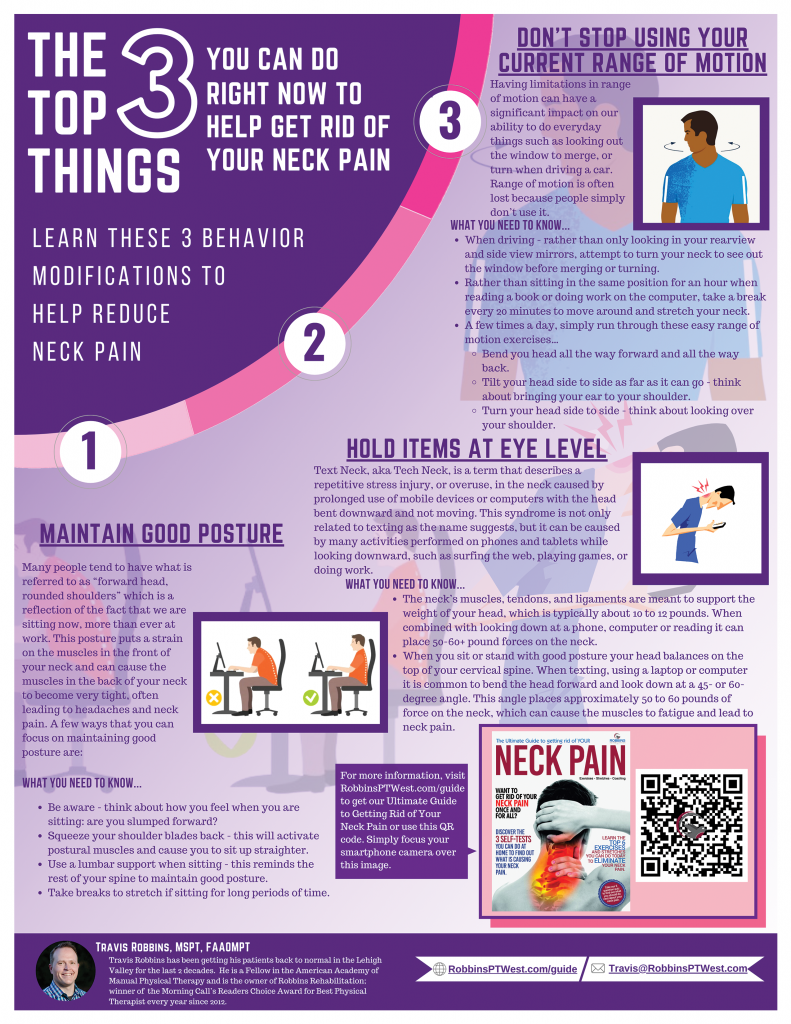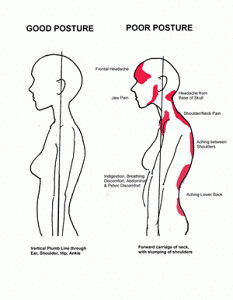
1. Maintain good posture
Many people tend to have what is referred to as “forward head, rounded shoulders” which relates back to the fact that we often sit throughout the day as that is what many jobs require. This posture puts a strain on the muscles in the front of your neck and can cause the muscles in the back of your neck to become very tight, often leading to headaches and neck pain. A few ways that you can focus on maintaining good posture are:
- Be aware – think about how you feel when you are sitting, are you slumped forward
- Squeeze your shoulder blades back – this will activate postural muscles and cause you to sit up straighter
- Use a lumbar support when sitting – posture starts at the bottom of the chain. If we are lacking the appropriate curves in our lumbar spine that will transmit up the chain causing our thoracic and cervical spinal curves to also be altered
- Take breaks to stretch if sitting for long periods of time

2. Hold items at eye level
- Text neck, aka Tech Neck, is a term that describes a repetitive stress injury or overuse in the neck caused by prolonged use of mobile devices or computers with the head bent downward and not moving. This syndrome is not only related to texting as the name suggests, but it can be caused by many activities performed on phones and tablets while looking downward, such as surfing the web, playing games, or doing work.
- The neck’s muscles, tendons, and ligaments are meant to support the weight of your head, which is typically about 10 to 12 pounds. When you sit or stand with good posture your head balances on the top of your cervical spine. When texting, using a laptop or computer it is common to bend the head forward and look down at a 45- or 60-degree angle. This angle places approximately 50 to 60 pounds of force on the neck, which can cause the muscles to fatigue and lead to neck pain.
- Tech neck is not only related to using technology – it can also become prevalent if you read often and hold the book on your lap, if you wear glasses (such as bifocals or trifocals) which cause you to look down to be able to see through a certain portion of your lense. The key is to move out of these positions rather than remaining in them for a prolonged period of time to give your neck muscles time to rest and recover.

3. Don’t stop using your current range of motion
- Having limitations in range of motion can have a significant impact on our ability to do everyday things such as looking out the window to merge or turn when driving a car. Range of motion may become limited due to a physiological impairment, however more often it is lost because people don’t use it.
- When driving – rather than only looking in your rearview and side view mirrors attempt to turn your neck to see out the window before merging or turning.
- Rather than sitting in the same position for an hour when reading a book or doing work on the computer take a break every 20 minutes to move around and stretch your neck.
- Vary the position you sleep in to avoid your neck being in the same position for a prolonged period of time, as this can cause our range of motion to adjust to our most commonly assumed positions

Your Next Move….
Find out what is causing YOUR neck pain. Get a free screen at Robbins Rehabilitation where after 30 minutes of 1-on-1 time with one of our Docs, you will get…
- A diagnosis – what is the cause of your pain
- A Prognosis – How long will it take for you to get back to normal?
- A Plan – A detailed explanation of what needs to be addressed to get you back to normal.
Stop guessing at what is causing your neck pain and get some answers. Call our free screen hotline at 610-295-9256 and schedule your free screen today.


